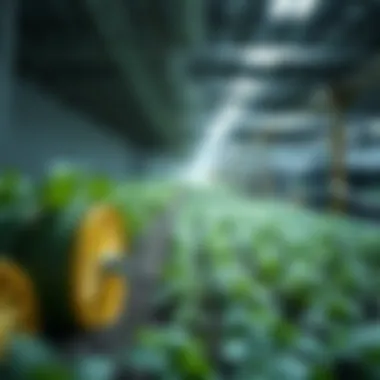Exploring Challenges and Innovations in Global Food Systems


Article Overview
The global food system represents an intricate web of relationships and processes, from the initial stages of agriculture to the final consumption by end-users. This section seeks to unravel these complexities, offering insights into the various challenges faced and the innovative strategies devised to combat them.
Purpose of the Article
The primary aim here is to illuminate the multifaceted nature of the food system and the pressing issues it grapples with today. Food security and sustainability are at the forefront, demanding urgent attention from all corners of the globe. The challenges include environmental degradation, inequitable access to resources, and the ever-evolving climate crisis, which threaten to disrupt food supply chains and agricultural practices. By analyzing these challenges and presenting innovative solutions, this article aspires to foster a deeper understanding of how individuals and institutions might contribute to a more resilient food system.
Relevance to Multiple Disciplines
This conversation is not limited to agriculture or environmental studies alone. Rather, it touches upon economics, sociology, public health, and technology. Students and professionals across diverse fields can benefit from the insights shared in this piece. Understanding the food system's implications extends beyond simply filling plates; it encompasses societal structures, economic stability, and overall human well-being.
Research Background
To fully grasp the current challenges and innovations, it's essential to look back at how the food system evolved and identify some of the key elements that shape today's landscape.
Historical Context
Historically, the food system has undergone significant transformations. From hunter-gatherer societies to the advent of agriculture, the trajectory has been dynamic. The Green Revolution of the mid-20th century drastically changed food production and greatly increased yields in many parts of the world. However, this progress has come with its own set of problems, such as reliance on chemical fertilizers, loss of biodiversity, and concentrated market power among large agribusinesses.
Key Concepts and Definitions
It’s crucial to clarify concepts that underpin discussions around the food system:
- Food Security: A scenario where all people have access to sufficient, safe, and nutritious food to meet their dietary needs for an active and healthy life.
- Sustainability: Practices that meet today’s needs without compromising the ability of future generations to meet theirs, particularly in agriculture and food production.
- Supply Chain Dynamics: The interconnectedness of production, processing, distribution, and consumption stages.
The global food system is not just a collection of food items; it's a complex ecosystem influenced by innumerable variables ranging from climate to politics.
The global food system is not just a collection of food items; it's a complex ecosystem influenced by innumerable variables ranging from climate to politics.
By comprehensively examining these aspects, the article contributes a substantial understanding of the intricacies involved in global food systems. Engaging with this material allows for an exploration of pathways toward a more equitable and sustainable future in food production and consumption.
For further exploration, consider visiting resources like Wikipedia, Britannica, and academic publications available on Google Scholar for extensive literature related to these themes.
Prelims to the Global Food System
The global food system is a vast and complex network that connects various elements, from agricultural methods to consumer habits. Understanding this system is not just an academic exercise; it is essential for addressing some of the most pressing issues that humanity faces today. As the world grapples with population growth, climate change, and economic disparities, the food system becomes a crucial focal point in the quest for sustainable solutions.
The importance of examining the global food system can be boiled down to several key factors:
- Interconnectedness: Food production and consumption do not happen in isolation. Changes in one region can ripple outwards, affecting markets, economies, and cultures globally.
- Food Security: An efficient food system is essential for ensuring that all people have access to sufficient, safe, and nutritious food. With many communities experiencing hunger or malnutrition, analyzing this system helps identify critical areas needing improvement.
- Sustainability: Unsustainable agricultural practices and high levels of waste challenge the planet's resources. By examining the global food system, we can find innovative approaches that align agricultural growth with environmental stewardship.
- Economic Impact: Agriculture is a significant part of the global economy. Understanding its mechanics, from production to distribution, highlights opportunities for economic development—especially in developing nations where agriculture could alleviate poverty.
The exploration of this complex system provides cannot be overstated. Insights from this examination can shape policies, empower communities, and foster advancements in food technology. By delving into the intricate elements of the food system, this article aims to illuminate the path forward for a sustainable and equitable global food landscape.
Definition of the Global Food System
Essentially, the global food system encompasses all processes involved in producing, processing, distributing, and consuming food. It includes the farmers who grow crops, the industries that transform these crops into consumable products, the logistics networks that facilitate distribution, and the consumers who ultimately purchase and consume these goods. This system operates on multiple levels—local, national, and global—each intertwined yet distinct. The definition isn’t just about the act of farming; it includes all the actions that stem from it and the underlying policies that support these activities.
Historical Overview
To understand the current dynamics of the global food system, one must take a step back in time. Historically, agriculture has been the backbone of civilizations. From the agricultural revolution, which set the stage for farming practices around 10,000 years ago, to today’s advanced agricultural technologies, the evolution of the food system has mirrored human development. The shift from subsistence farming to large-scale agriculture during the Industrial Revolution transformed food production profoundly.
In more recent decades, globalization has intensified the interconnectedness of food systems across borders. The growth of multinational food corporations and the establishment of free trade agreements have reshaped how food is produced and consumed worldwide.
However, this rapid evolution hasn’t come without challenges. Events like the 2007–2008 food price crisis, which led to protests in over 30 countries, and the ongoing pandemic disruptions underscore the fragility of this system. By tracing the historical threads of the global food system, one can appreciate both its triumphs and its vulnerabilities. Thus, understanding its past informs our approach to future challenges in food security, sustainability, and economic stability.
Key Components of the Food System
Understanding Key Components of the Food System is crucial, as these facets intertwine to shape how we produce, process, and consume food. Each component plays a unique role in the overall functioning of the food system, addressing the multifaceted challenges we face today such as food security, sustainability, and economic viability. By dissecting these elements, we can better comprehend not only their individual significance but also their collective impact on global food dynamics.


Agricultural Production
Conventional vs. Organic Farming
In the realm of agricultural production, the debate between conventional and organic farming practices continues to spark intrigue. Conventional farming leverages chemicals and fertilizers, allowing for high yields and efficient pest control. On the flip side, organic farming emphasizes natural processes and often results in lower yields but can enhance soil health and biodiversity over time.
The key characteristic distinguishing these two methods revolves around input usage. Conventional practices generally prioritize immediate productivity, while organic farming places a premium on sustainability. Though organic farming may seem costlier—both in time and resources—its benefits, such as improved nutritional quality and reduced chemical exposure, can make it an appealing option for conscientious consumers.
Precision Agriculture
Precision agriculture represents a fascinating advancement in farming practices, prioritizing efficiency by employing technology to assess and manage crops at a micro-level. Utilizing a combination of GPS, sensors, and big data, farmers can optimize inputs like water and fertilizers based on specific field conditions—leading to increased yields and reduced waste.
A hallmark of precision agriculture is its data-driven approach. This not only assists in environmental sustainability but also enhances economic returns for farmers through better resource management. However, the initial investment in technology can be a barrier, leading some small-scale farmers to miss out on these advancements.
Food Processing
Industrial Food Production
The method of industrial food production plays a pivotal role in shaping the availability and accessibility of food globally. This approach emphasizes mass production through mechanization and automation. One of its core advantages is the ability to meet the ever-growing demands of the global population efficiently.
However, industrial production often raises concerns about food quality and nutritional value. The heavy processing involved can strip foods of essential nutrients, so while it ensures food availability at a lower price point, it may compromise health aspects as well.
Sustainability in Food Processing
In contrast, the concept of sustainability in food processing aims to marry productivity with environmental responsibility. This approach seeks to minimize waste and energy consumption while diversifying production methods, fostering a healthier planet.
The rise of eco-friendly practices within food processing serves as a remedy to the challenges posed by traditional food manufacturing. Emphasizing local sourcing and reduced carbon footprints, sustainable processing encourages a more resilient agricultural landscape. Yet, the transition can be a slow burn, as many industries grapple with integrating these practices in a cost-effective manner.
Distribution and Logistics
Global Supply Chains
The complexity of global supply chains is often underestimated in discussions about food systems. These interconnected networks facilitate food distribution from farms to consumers across continents. Each stage in the supply chain—from processing to transportation—bears implications for food quality, safety, and availability.
A major strength of global supply chains is their ability to bring diverse food options to various markets. However, they also face challenges such as volatility due to geopolitical factors and climate change, which can disrupt food flow and lead to scarcity in some regions.
Transportation Challenges
Transportation challenges present a significant hurdle in the quest for efficient food distribution. Issues such as logistical bottlenecks, inadequate infrastructure, and rising fuel costs can hinder the timely delivery of food products, often resulting in spoilage.
The efficiency of transportation systems directly correlates to food security and accessibility. While innovations in logistics, such as improved tracking systems, aim to mitigate these challenges, systemic barriers remain prevalent, affecting the food system's overall resilience.
Consumption Patterns
Cultural Influences on Diet
Cultural influences significantly shape consumption patterns worldwide, determining what people eat and how their diets evolve. Local traditions, availability of ingredients, and historical practices all contribute to these patterns, reflecting a society's identity.
Understanding these dynamics is vital for enhancing global food systems, as culturally tailored food solutions can encourage healthier choices. Yet, globalization can sometimes dilute local diets, emphasizing the need to preserve traditional practices while introducing innovative, healthful options.
Health Implications of Food Choices
Finally, the health implications of food choices must not be overlooked. The food we consume affects our health profoundly, from the risk of chronic diseases to overall wellbeing. With the rise of processed foods and fast dietary changes, educational programs are essential to foster healthier choices.
Promoting awareness of nutritional information and the benefits of balanced diets plays an instrumental role in combating health issues. However, navigating between convenience and health often poses a quandary for consumers, making effective messaging and accessible resources crucial.
"The interaction of cultural and economic factors leads to a complex web of consumption patterns that ripple through the global food system."
"The interaction of cultural and economic factors leads to a complex web of consumption patterns that ripple through the global food system."
In summary, dissecting the key components of the food system—from agricultural practices to consumption patterns—reveals their interconnectedness and the challenges and innovations at play. Such an analysis not only deepens our understanding but also informs strategies for creating a more sustainable and equitable food landscape.


Challenges Facing the Global Food System
Importance of Challenges Facing the Global Food System
The global food system is akin to a massive web, with threads connecting agriculture, economics, environmental policies, and social dynamics. As this web becomes increasingly complex, various challenges threaten its stability. Understanding these challenges is essential to navigate the intricacies of food production, distribution, and consumption. Addressing issues such as food security, environmental impacts, and economic disparities is not merely a choice; it's an urgent necessity. These challenges, if not tackled, can lead to dire consequences ranging from heightened malnutrition rates to increased resource conflicts. The aim is not just to identify these challenges, but also to explore innovative solutions that can lead to a more resilient food system.
Food Security Concerns
Malnutrition
Malnutrition is perhaps the most visible manifestation of instability within the food system. It doesn't just imply a lack of food, but a qualitative deficiency that impacts health. The sheer numbers are staggering; millions are affected, suffering from either undernourishment or obesity—both linked to food availability and accessibility. In this context, one must recognize malnutrition’s complexity; it’s not only about calories but critical nutrients. By shining a light on this issue, we derive insight into how food quality intersects with public health. Addressing malnutrition requires innovative nutritional strategies and public health initiatives, underscoring the intricate ties between the global food system and individual welfare.
Poverty and Access Issues
Poverty is a leading contributor to food insecurity, acting like an anchor that drags down the most vulnerable. Without adequate income, families struggle to afford nutritious food, leading to a vicious cycle of hunger and health issues. One key characteristic of this problem is its geographic variability; urban and rural areas face unique challenges. Tackling access issues demands a multi-faceted approach—including economic support, infrastructure development, and education about nutrition. It’s not quality food access that alone matters, but the ability and power to purchase it. This stark reality emphasizes the need for systemic change across economic levels to close the gap in food access.
Environmental Impact
Climate Change Effects
Climate change compounds existing challenges in the global food system, causing crop yields to fluctuate unpredictably due to extreme weather events. One major characteristic of this impact is its irreversibility; a drought in one year doesn’t just affect that harvest but influences future planting cycles as well. Farmers face an uphill battle against shifting climates, and this unpredictability can lead to wide-ranging economic ramifications. Dialogues around mitigation strategies are vital, addressing how agriculture can adapt to climate changes while maintaining food supply. If innovative agricultural practices can be successfully integrated, it may stave off some adverse effects, making climate resilience a crucial part of the conversation.
Biodiversity Loss
Biodiversity loss is not merely an environmental issue; it reverberates through the food system itself. The variety of crops available allows for resilient ecosystems and richer diets. However, modern agricultural practices often rely on monocultures, which undermine biodiversity. One unique feature of discussing biodiversity is its interconnectedness to climate stability and soil health; the loss of plant species can lead to the degradation of ecosystems essential for food production. Recognizing the importance of biodiversity in agriculture drives home the necessity for sustainable practices. Addressing biodiversity issues can yield advantages not only for the environment but also for ensuring long-term food security.
Economic Disparities
Inequities in Resource Distribution
The distribution of resources in the food system starkly reflects broader social inequities. Wealthier nations often command the lion's share of food production and distribution, leaving poorer nations struggling to feed their populations. This characteristic starkly reveals a fundamental flaw in the system; when resources are hoarded, it creates imbalances. Unequal access to technology, land, and financial investment further exacerbates these disparities. Tackling inequities in resource distribution is crucial to ensuring that food systems operate efficiently and sustainably, promoting fairness and economic resilience as core values.
Market Fluctuations
Market fluctuations are another vital concern within the global food system. Prices can rise or fall dramatically due to changing demands, geopolitical issues, or natural disasters. A key aspect of this phenomenon is its unpredictable nature. While fluctuations can create opportunities for some, they often devastate the livelihoods of small-scale farmers who lack the safety nets available to larger operations. Managing these fluctuations demands a robust framework of support for vulnerable populations, ensuring that food remains accessible regardless of market volatility. Through understanding these variations, we can better formulate strategies to stabilize food prices and support those most affected by the ups and downs of the food market.
Innovative Approaches to Addressing Food System Challenges
The complexities of the global food system necessitate innovative approaches to effectively tackle its numerous challenges. As we witness climate change affecting agricultural productivity and food security becoming an ever-present concern, the importance of innovation cannot be overstated. This section delves into three pivotal avenues of innovation: sustainable agricultural practices, advanced technologies, and effective policy and governance initiatives. Each contributes distinctly to enhancing the overall food system resilience and sustainability.
Sustainable Agricultural Practices
Agroecology
Agroecology stands out in the realm of sustainable farming techniques. It emphasizes ecological principles to create farming systems that are not only productive but also environmentally sound. The key characteristic of agroecology is its holistic approach, integrating various components such as biodiversity, soil health, and farmer knowledge into farming practices. This makes it a popular choice for enhancing sustainability.
One unique feature of agroecology is its reliance on natural processes rather than synthetic inputs, which fosters a resilient agricultural system. Crops are cultivated in a manner that promotes symbiotic relationships—like planting beans alongside corn to facilitate growth while naturally nourishing the soil. However, while the advantages are significant, including reduced chemical use and enhanced biodiversity, there can also be challenges such as the transition from conventional methods and the need for extensive farmer education.
Permaculture Techniques
Permaculture techniques offer another pathway toward sustainable agriculture. This method focuses on designing agricultural systems that mimic natural ecosystems, creating a self-sustaining environment. A core characteristic of permaculture is its emphasis on permanent cultivation practices that yield food with minimal impact on the environment. Thus, it presents a beneficial avenue for farming in an era increasingly concerned with ecological footprints.
A unique feature of permaculture is its application of principles such as zoning and sector analysis, which optimize land use and resource management. The advantages are clear: increased local food production, reduced waste, and enhanced community resilience. On the flip side, its initial setup can be labor-intensive, requiring significant upfront planning and labor before realizing long-term benefits.
Advanced Technologies
Vertical Farming
Vertical farming, a modern approach to food production, addresses the rapid urbanization and land scarcity by utilizing confined spaces like buildings. The main characteristic of vertical farming is that it maximizes production in a limited area, often using hydroponics or aeroponics, leading to more efficient water use. This innovation is particularly beneficial in urban settings where traditional farming is not viable.


One unique feature of vertical farms is the ability to control environmental factors, resulting in faster crop growth and year-round production. While the advantages of increased productivity and reduced transportation costs are promising, challenges exist, including high energy requirements and initial investment costs, which can deter potential investors.
Biotechnology in Crop Improvement
Biotechnology plays a crucial role in enhancing crop resilience and yields, particularly in the face of climate change. The primary aspect of biotechnology encompasses genetic modifications that improve traits such as drought tolerance or pest resistance. This characteristic makes it a significant component of discussions about food security and sustainability.
One notable feature of biotechnological innovations is their potential to produce crops with higher nutritional values, which can address malnutrition concerns globally. However, while there are substantial benefits in terms of increased efficiency, ethical considerations and potential long-term ecological impacts raise important questions that ongoing research must consider.
Policy and Governance
Global Food Policies
Global food policies are instrumental in shaping food systems at both international and national levels. The main focus here is on how these policies coordinate efforts to ensure food security while promoting sustainable practices. An effective global food policy is essential to align diverse stakeholder goals, from governments to non-profit organizations.
A unique characteristic of such policies is the emphasis on multi-stakeholder engagement, fostering collaboration among various entities. Yet, the challenge lies in balancing competing interests and resources, which can lead to conflicts or ineffective outcomes. The necessity for comprehensive and adaptable policies underscores the dynamic nature of food systems and a need for regular assessment.
Local Governance Initiatives
On the ground, local governance initiatives can significantly impact food systems, addressing community-specific challenges. These initiatives often focus on local food productions and education, allowing communities to play a role in their own food security. A key characteristic of these initiatives is their adaptability to local needs and contexts, promoting participation from local farmers and residents.
A distinct feature of local governance projects is the ability to tailor solutions that consider cultural, economic, and ecological factors specific to the area. While advantageous for fostering local resilience and collaboration, these initiatives can struggle with limited funding and resources, which often affect their reach and effectiveness.
In summary, the innovative approaches outlined above provide a broad spectrum of solutions that not only address the pressing challenges of the global food system but also foster an environment of collaboration, sustainability, and resilience. By embracing these innovations, it is possible to create a more secure and sustainable food future for all.
The Future of the Global Food System
The future of the global food system is an arena of transformative potential, where challenges meet innovations head-on. The importance of examining this topic lies in understanding how shifts in consumer behavior, the focus on sustainability, and the collaborative efforts of nations and research entities can redefine food production and distribution worldwide. As the global population swells and environmental pressures mount, the necessity for a food system that is resilient, equitable, and sustainable becomes clear.
Predicted Trends
Shifts in Consumer Preferences
One notable aspect of shifts in consumer preferences is the growing inclination towards plant-based diets. As more individuals become aware of the health benefits associated with these diets—like lower risks of heart diseases and increased longevity—it's clear why this trend is gaining momentum. This shift is not just a fleeting fad; it's turning into an entrenched mindset where consumers are demanding choices that align with their health aspirations and ethical values.
A key characteristic of these shifts is the emphasis on transparency. Consumers today want to know where their food comes from and how it's produced. They often favor brands that can trace their products back to sustainable origins. This approach is not only beneficial but also popular among environmentally conscious buyers. The unique feature here is the trend towards supporting local farmers and businesses, thus fostering community engagement and economic growth while reducing carbon footprints.
However, challenges linger, such as accessibility and affordability of plant-based options, which can sometimes remain out of reach for lower-income consumers.
Increased Focus on Sustainability
The rising emphasis on sustainability shapes how future food systems are perceived. This focus means a robust movement toward environmentally friendly farming techniques and packaging that minimizes waste. Sustainable practices promote regenerative agriculture, which benefits the land by improving soil health and biodiversity. This aspect of sustainability is essential; it reduces the environmental toll agriculture often takes, thus aligning agriculture with ecological well-being.
The remarkable feature of this increased focus is the push for innovation in sustainable practices, including methods such as aquaponics and permaculture. These techniques provide opportunities for more inclusive food production systems that consider ecological balance. A major advantage here is that sustainable choices often lead to products with more nutritional value, benefiting both consumers and the planet. Nonetheless, this shift may require significant investment and education, posing potential hurdles for widespread adoption.
Global Cooperation and Research
International Collaborations
International collaborations form an essential part of addressing the food system's complexities. Collaboration among governments, NGOs, and private sectors fosters ideas and strategies to manage global challenges effectively. The unique benefit of these collaborations lies in their ability to harness diverse expertise and resources, providing solutions that individual nations might struggle to implement alone.
One of the most impactful characteristics of international collaborations is the development of global standards for sustainable practices. This collective effort not only streamlines food safety regulations but also promotes fair trade policies to assist developing nations in gaining fair access to global markets. However, challenges related to coordination and prioritization can sometimes impede progress in these partnerships.
The Role of Research Institutions
Research institutions play a pivotal role in shaping the future of the global food system by informing policy and practice through cutting-edge research. They are instrumental in developing innovative agricultural methods and technologies that can address pressing issues in food security and sustainability. The significance of their work cannot be overstated; through rigorous testing and validation of new practices, they contribute to a body of knowledge that drives the industry forward.
The defining feature of research institutions is their capacity to serve as independent thought leaders. This autonomy allows them to pose critical questions and pursue innovative solutions without the constraints of commercial interests. Their work often results in actionable insights that benefit farmers, policymakers, and communities alike. However, there is a challenge here as well: funding limitations and bureaucratic hurdles can slow down vital research processes.
Epilogue
In summary, the future of the global food system hinges on understanding the interplay between consumer preferences, sustainability, and cooperation on a global scale. As trends evolve, the focus on diets that emphasize health and sustainability is likely to continue growing, while collaborative efforts will be crucial in breaking down barriers to innovation and research. By addressing these elements now, we set the foundation for a food system that is not just productive, but resilient enough to meet the demands of future generations.
Investing in a collaborative and sustainable future is not merely an option; it's a responsibility we hold for the next generation.
Investing in a collaborative and sustainable future is not merely an option; it's a responsibility we hold for the next generation.
For in-depth information on international efforts and sustainable practices, visit Food and Agriculture Organization, World Wildlife Fund, and United Nations. Keep abreast of changes with scholarly articles found on Google Scholar or ResearchGate.



